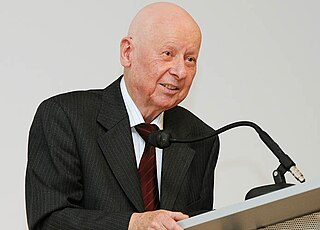Related Research Articles

The GSI Helmholtz Centre for Heavy Ion Research is a federally and state co-funded heavy ion (Schwerion) research center in the Wixhausen suburb of Darmstadt, Germany. It was founded in 1969 as the Society for Heavy Ion Research, abbreviated GSI, to conduct research on and with heavy-ion accelerators. It is the only major user research center in the State of Hesse.

The Universal Linear Accelerator (UNILAC) is a heavy ion linac based at the GSI Helmholtz Centre for Heavy Ion Research near Darmstadt, Germany. It can provide beams of accelerated ions of elements from hydrogen to uranium with energies of 2 to 11.4 MeV / u.
The Helmholtz Association of German Research Centres is the largest scientific organisation in Germany. It is a union of 18 scientific-technical and biological-medical research centers. The official mission of the Association is "solving the grand challenges of science, society and industry". Scientists at Helmholtz therefore focus research on complex systems which affect human life and the environment. The namesake of the association is the German physiologist and physicist Hermann von Helmholtz.
Victor Ninov is a Bulgarian physicist and former researcher who worked primarily in creating superheavy elements. He is known for the co-discoveries of elements 110, 111, and 112.
Wilhelm Walcher was a German experimental physicist. During World War II, he worked on the German nuclear energy project, also known as the Uranium Club; he worked on mass spectrometers for isotope separation. After the war, he was director of the Institute of Physics at the University of Marburg. He was a president of the German Physical Society and a vice president of the German Research Foundation. He helped found the Society for Heavy Ion Research and the German Electron Synchrotron DESY. He was also one of the 18 signatories of the Göttingen Manifest.
Horst Stöcker is a German theoretical physicist and Judah M. Eisenberg Professor Laureatus at J.W. Goethe – Universität, Frankfurt.
Wolfgang Gentner was a German experimental nuclear physicist.
Klaus Blaum is a German physicist and director at the Max Planck Institute for Nuclear Physics in Heidelberg, Germany.
Sigurd Hofmann was a physicist known for his work on superheavy elements.
The Hans A. Bethe Prize, is presented annually by the American Physical Society. The prize honors outstanding work in theory, experiment or observation in the areas of astrophysics, nuclear physics, nuclear astrophysics, or closely related fields. The prize consists of $10,000 and a certificate citing the contributions made by the recipient.
Friedrich-Karl "Friedel“ Thielemann is a German-Swiss theoretical astrophysicist.

Gerhard Kraft (29.10.1941-18.3.2023) was a German physicist, best known for introducing heavy ion cancer therapy in Europe.

The Facility for Antiproton and Ion Research (FAIR) is an international accelerator facility under construction which will use antiprotons and ions to perform research in the fields of: nuclear, hadron and particle physics, atomic and anti-matter physics, high density plasma physics, and applications in condensed matter physics, biology and the bio-medical sciences. It is situated in Darmstadt in Germany.

Paolo Giubellino is an experimental particle physicist working on High-Energy Nuclear Collisions. Currently he is the joint Scientific Managing Director of the Facility for Antiproton and Ion Research (FAIR) and the GSI Helmholtz Centre for Heavy Ion Research (GSI) and Professor at the Institute of Nuclear Physics of the Technische Universität Darmstadt.
Sanja Damjanović is a physicist from Montenegro and was minister of science in the government of Montenegro from 2016 until 2020.

Jens Dilling is an experimental nuclear physicist and currently the director of institutional strategic planning at Oak Ridge National Laboratory.
Alexandre Obertelli is a French experimental nuclear physicist and Alexander von Humboldt Professor of Experimental Nuclear Structure Physics at the Institute of Nuclear Physics of the Technische Universität Darmstadt.
Sonia Bacca is an Italian physicist known for her calculations of the interaction forces of small systems of nucleic particles. She is University Professor in Theoretical Physics at the Institute for Nuclear Physics of the University of Mainz in Germany.
Hannah Elfner is a German physicist who is Head of Simulations at the Helmholtz Centre for Heavy Ion Research and Professor of Physics at the Goethe University Frankfurt. She was named the 2021 Alfons and Gertrud Kassel Foundation Scientist of the Year.
Madappa Prakash is an Indian-American nuclear physicist and astrophysicist, known for his research on the physics of neutron stars and heavy-ion collisions.
References
- ↑ Birth date and place from German National Library catalog entry, retrieved 2022-09-24
- ↑ "Almudena Arcones", People, TU Darmstadt Institut für Kernphysik Theory Center, retrieved 2022-09-24
- 1 2 Almudena Arcones elected Fellow of the American Physical Society (APS), GSI Helmholtz Centre for Heavy Ion Research , retrieved 2022-09-24
- ↑ "Fellows nominated in 2020 by the Division of Nuclear Physics", APS Fellows archive, retrieved 2022-09-24